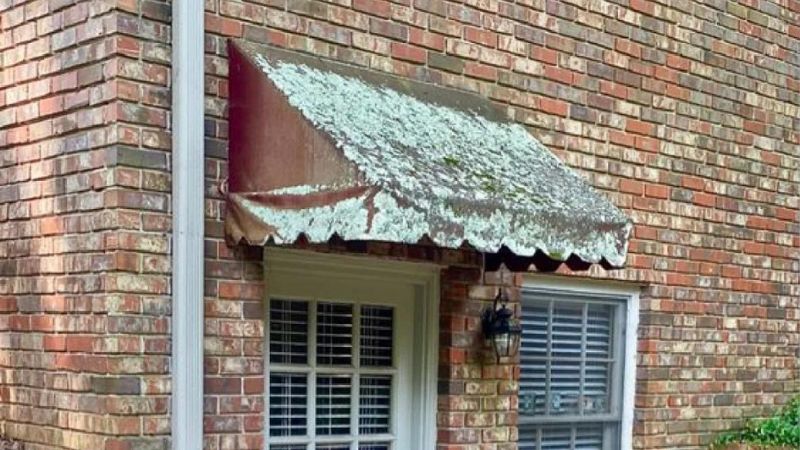Awnings provide shade and protection, but they can also accumulate dirt, dust, and mildew over time. Knowing how to clean your awning at home is essential for maintaining its longevity and keeping it looking fresh. Regular cleaning not only enhances the appearance of your awning but also prevents damage from mold and environmental pollutants.
Whether your awning is made of fabric or metal, you can clean it effectively with simple household items. In this blog, we’ll walk you through easy, step-by-step instructions to clean your awning at home without needing professional help. From removing stubborn stains to protecting the material from future dirt build-up, we’ve got you covered. So, let’s dive into the best techniques for keeping your awning in top shape all year round, ensuring it continues to add beauty and functionality to your outdoor space.
How To Clean Your Awning At Home?
1. Gather Your Cleaning Supplies
Before you start cleaning your awning, it’s important to gather all the necessary supplies. Depending on the material of your awning—whether it’s fabric, metal, or vinyl—you’ll need specific cleaning products. Basic items you should have include a soft brush, mild soap or detergent, a bucket of water, and a garden hose.
For tougher stains or mildew, you might also need a solution of white vinegar or a special awning cleaner. Avoid using harsh chemicals like bleach, as they can damage the awning’s fabric or color. Having everything ready before you begin will make the cleaning process smoother and more efficient.
Also Read:- Basic Steps of RV Awning Maintenance
2. Inspect Your Awning Before Cleaning
Before you start scrubbing away, inspect your awning for any damage or areas that might need special attention. Look for any rips, tears, or weak spots that could be made worse during cleaning. If you notice any problems, consider fixing them before proceeding.
Also, take note of any mildew, mold, or bird droppings that may require extra cleaning effort. By identifying problem areas ahead of time, you can address them more effectively during the cleaning process. Regular inspections like this can also help you spot issues before they become serious, saving you money on repairs or replacements.
3. Brush Off Loose Dirt and Debris
Once you’ve inspected your awning, the first step is to remove any loose dirt, dust, leaves, or other debris from the surface. Use a soft-bristled brush or a broom to gently sweep away any buildup. Brushing away debris before using water will prevent the dirt from becoming ingrained in the fabric or material, making the cleaning process easier and more effective.
If you have a retractable awning, make sure to clean both the top and underside of the awning. This simple step is crucial in ensuring your awning stays as clean as possible.
4. Use a Mild Cleaning Solution
For most awnings, a mild soap or detergent mixed with lukewarm water is sufficient to clean the surface. Fill a bucket with this solution, and use a soft brush or sponge to apply it to the awning. Work in sections, gently scrubbing the surface to remove dirt and stains.
Be careful not to scrub too hard, especially on fabric awnings, as this could damage the material. After applying the soap solution, allow it to sit for a few minutes to break down the dirt before rinsing it off. For vinyl or metal awnings, you can use a soft cloth instead of a brush to avoid scratching the surface.
5. Rinse Thoroughly with a Garden Hose
After scrubbing your awning with soap, it’s important to rinse it thoroughly. Use a garden hose with moderate water pressure to wash away the soap and any remaining dirt. Ensure that all traces of the cleaning solution are gone, as leftover soap can attract more dirt over time.
When rinsing, start from the top of the awning and work your way down to prevent streaking or residue from forming. Avoid using a pressure washer, as the force of the water can damage both fabric and metal awnings. A thorough rinse will leave your awning looking fresh and free from any cleaning product residues.
6. Tackle Stubborn Stains and Mildew
For tough stains like bird droppings, tree sap, or mildew, you may need to use a stronger cleaning solution. To make a powerful yet environmentally safe cleaning solution, combine equal parts white vinegar and water. Apply this solution directly to the stained areas using a sponge or cloth, and let it sit for 10-15 minutes.
Afterward, scrub the area gently with a soft brush and rinse thoroughly with a garden hose. Proceed with step one again if the stains are still noticeable. For particularly stubborn mildew, you can use a commercial awning cleaner, but always test it on a small, inconspicuous area first to ensure it won’t damage the material.
7. Let Your Awning Dry Completely
Once your awning has been thoroughly rinsed, allow it to dry completely before retracting it or using it again. Moisture left on the awning can lead to mold or mildew growth, especially in fabric awnings. To speed up the drying process, you can gently pat the surface with a clean towel or cloth.
Ensure that the awning is fully extended and exposed to air so that both the top and underside can dry. If possible, leave it out in the sun, as sunlight helps to kill any remaining bacteria or mold spores.
8. Apply a Protective Coating
To extend the life of your awning, consider applying a protective coating after cleaning. There are products available specifically designed to protect awnings from UV damage, mold, and mildew. These coatings create a barrier on the surface, preventing dirt from adhering as easily and protecting the material from harmful environmental factors.
Make sure the awning is completely dry before applying any protective products. This additional step can greatly reduce the frequency of cleaning and keep your awning looking fresh for longer periods.
Also Read:- How To Remove Mould From Canvas Awnings
9. Perform Regular Maintenance
Maintaining your awning in top shape requires routine care. Instead of waiting for dirt and stains to build up, clean your awning every few months, or at least twice a year, depending on its exposure to the elements. Additionally, retract your awning during heavy rain or wind to avoid damage.
Checking for mold, mildew, and dirt regularly will help you catch any issues early, making cleaning easier and preventing long-term damage. A well-maintained awning not only improves the appearance of your outdoor space but also saves you money on repairs or replacements down the line.
Conclusion
Cleaning your awning at home doesn’t have to be a daunting task. With the right materials and proper technique, you can easily restore your awning’s look and ensure its durability for years. Regular maintenance will help you avoid costly replacements and keep your outdoor space looking great.
So, set aside a little time to follow the steps outlined, and your awning will thank you with lasting performance and charm. If needed, don’t hesitate to consult your awning’s care manual for specific guidelines on cleaning and upkeep.
FAQs
How often should I clean my awning at home?
It’s recommended to clean your awning every 6-12 months to prevent dirt buildup and mildew growth.
What is the best way to remove mold from my awning?
A mild solution of water and dish soap, or a mix of water and white vinegar, can effectively remove mold from most awnings.



